A Closer Look
Once the packing materials are stripped away—a process that does not, thankfully, require scissors, box cutters, or high-powered lasers—we see the mouse itself, along with a black folder. Opening it up, the folder itself yields the driver download CD (more on that later), the manual, a certificate of authenticity, and a couple of stickers. There’s also a promotional card, though why Razer feels the need to advertise the product inside the product’s own packaging, I can’t say. Excess enthusiasm, maybe?
Looking at the mouse itself, the Salmosa is clearly designed from a minimalist standpoint. The top is covered in matte black rubber, which provides a grippy, easy to clean surface. The two main buttons are huge, taking up 2/3 of the mouse’s top surface. A bit of experimentation showed that they are clickable along their entire length, which indicates a remarkably well-balanced hinge mechanism. The mouse wheel is notchy and easy to scroll and click, though it could use more texturing on the wheel surface for grip. As has become standard with Razer mice, the plastic-covered cable is thin, flexible, and seven feet long. Over time the cable does have a tendency to kink up if you wrap it up too tightly, so a bit of care is warranted.
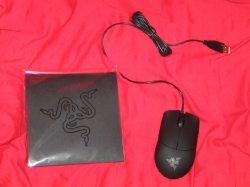 |
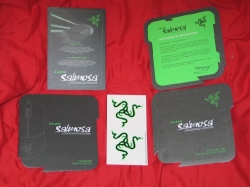 |
| Box contents | What’s inside that black folder |
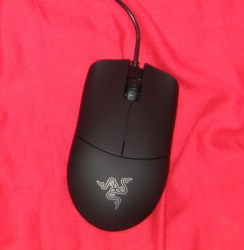 |
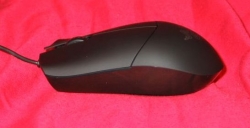 |
| Top view | Left side |
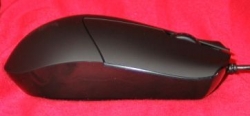 |
 |
| Right side | Mouse bottom |
True to the minimal esthetic, there are no extra buttons on the Salmosa. While some may not lament the lack, I frequently found myself reaching for the back and forward buttons that are not there. The Salmosa is not without extra features, though. Flip it over, and you’ll see a couple of recessed slide switches. The one on the left controls the tracking resolution, swapping between 800dpi and 1800dpi. While the ability to change resolutions is nice, putting the switch on the bottom of the mouse makes it impractical to use while in-game. I found myself setting it to 1800 dpi and leaving it alone, which is what most people will probably end up doing. The right hand switch controls the USB polling rate, which determines how many times per second the mouse sends reports to the system. For best accuracy, this rate should be set to 1000hz when possible. This does impose an extra bit of CPU overhead, however, so people with older systems may need to set it lower, to 500hz, or even 125hz if the problems persist.
The other main noticeable feature about the bottom side is the PTFE feet. The pads themselves are surprisingly small, but carefully placed to avoid drag. In practice I have noticed no friction or slowdown issues at all—indeed, the ease with which this mouse will slide around took some getting used to, compared to the big heavy mice I have used in the past.

[…] Click the icon, or enter email address to receive reviews via email! We will not share your info! When I hear the words gaming mouse, two thoughts come to mind. Ooh, thats interesting, is followed …Read more… […]
[…] TechwareLabs gets its hands on the Razer Salmosa Gaming Mouse […]